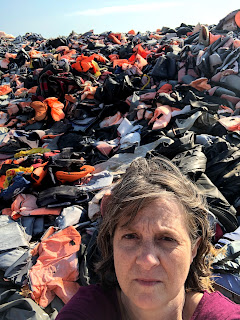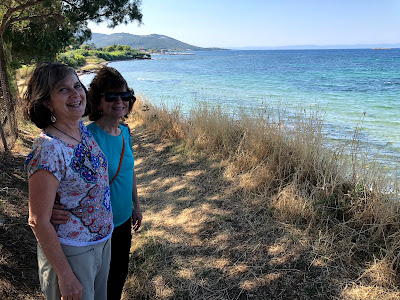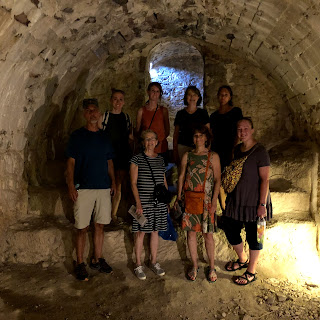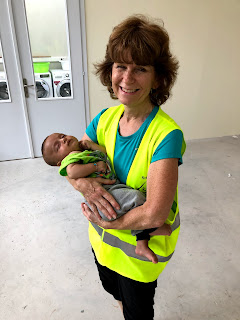12) Camp Moria
While this is definitely NOT a tourist attraction, our whole team was interested in getting an up-close look at the refugee camp. It helped us to process what daily living is like for the women and children that visit the center. William took us through the camp in small groups. We weren't supposed to take photos except with much discretion. I tried to "shoot from the hip" with my phone. I'm not including the several photos I took of my sandals and the sky.
11) Errosos
This beach is recommended as the #1 beach on Lesvos. I was not impressed. It is probably the most like American beaches - crowded, hard to find parking, lots of opportunities to spend money, etc. It also had the hottest sand I have ever stepped on. Truly painful. But still pretty.
10) Molyvos
We drove like crazy to get to this castle before it closed (every tourist site closes at 3 PM). You can see it all in 30 min or less, though. Its history is a bit sketchy - it was built, destroyed, built again, destroyed again, built again, and then destroyed by an earthquake in 1867 at which point they gave up. The ruins had good views.
Also, near Molyvos, there is a site that is quite sobering. It is the lifejacket graveyard - the remains of lifejackets and boats used by the refugees that have come through Lesvos in recent years. I would say that's a photo of me looking sober, but that's just the face I make when taking selfies.
9) Petra
This beach was a step up from Errosos. For the price of a Diet Coke, you can sit in a chair under an umbrella all day. Instead, we just stayed about an hour. It was definitely hot enough to enjoy a dip in the cool Aegean.
8) Thermis
This place was very close to where we were staying, so it was just a quick trip up the road. There is a "prehistoric archeological site" there that was already closed, but we had a lovely walk along the beach.
7) Xampelia Beach
This beach was about a 30 min. drive up the coast from Panagiouda. The beach had mostly small rocks instead of sand, and there was some annoying seaweed (which looked like confetti paper) floating on top of the water, but this was a nice little beach. It was a great place to take a quick swim, relax, and buy a cold drink (here's where we discovered some Stevia-sweetened diet drinks).
We also saw a local artist at work making some incredible 3-D mosaics out of shells. The large restaurant on the beach was totally decorated with this artwork - including all four walls and the ceiling. A quick internet search told me the artist's name is George Hatzinikolas. Here's one of the smaller pieces, but many were as big as 4 ft X 6 ft.
6) Roman Aqueduct
We visited this little place near Moria on one of our last evenings on Lesvos. It was only about a 15 min. drive from our hotel, through the narrow streets of the small village of Moria (not the same as the camp, but the town from whence the camp gets its name), and up into the hills above town. We all really thought it looked like something from Lord of the Rings - a massive structure built by an ancient empire in what looks to be like the middle of nowhere! Historians think it was built by Hadrian. So I have now seen Hadrian's Wall, Hadrian's Arch and now Hadrian's Aqueduct. I need to see what else he built so that I can make a bucket list.
5) Agiassos
This was a cute little village at the base of Mt. Olympus. It was very picturesque, with a large church in the center of town. We had fun walking around. I might have liked it a little more, but it was full of little trinket shops and had a bit of a "tourist-trap" feel to me. The omelette I ate there was one of the best things I tasted on the trip. One of the filling ingredients was French fries!
4) Skala Sykamineas
This town on the northeast coast of Lesvos is just so cute! Some might like Agiassos better, but this one has the Aegean and lovely little jewelry stores. This is also the spot where most of the refugees arrive by boat. This little community has rescued many lives.
Melanie and I bought matching fish bracelets. The shopkeeper told us that the fish symbolizes good luck and flexibility. I told her the fish represents Jesus to us! I also think it's a great reminder of the little town that plucks these precious souls from the sea and a reminder to us that we are fishers of men.
3) Mytilini
By far the biggest town on Lesvos, we have a record in the New Testament that this harbor was visited by Paul. It has a lovely stretch of sidewalk going all the way around an oval-shaped harbor, and it is magical-looking in the evening. There are restaurants and stores across the street - even a place called "The Sugar Store" which was a favorite. It also has a very interesting castle on the hill with great views from high above and even a cool crypt down below.
2) Mt. Olympus
This was a favorite spot for our team. Terry had been trying to figure out a way to get to the top of this mountain since he first saw it. Turns out there is a road that goes up to the top. We stopped a little bit short of the top (the road was a bit scary), and hiked the last bit of the way. We had a great view of much of the island and stayed up there quite a while taking it all in.
There was a Greek orthodox chapel at the very top along with this cool cross:
1) Panagiouda
My number one spot on this island is the little town that we called home for two weeks. I loved the peaceful harbor, the wonderful restaurants right on the water, the silver church dome that sparkled at sunset, the clock tower lit up at night, our colorful little hotel, the local swimming hole and the wonderful people (more about them in a post to come).























































